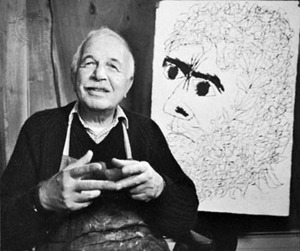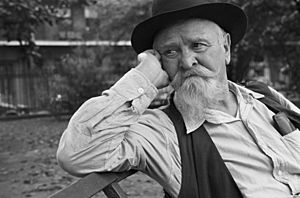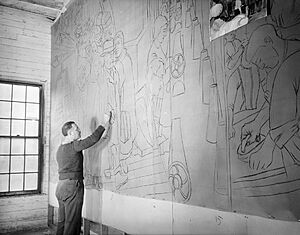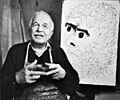Ben Shahn facts for kids
Quick facts for kids
Ben Shahn
|
|
|---|---|
 |
|
| Born |
Benjamin Shahn
September 12, 1898 Kaunas, Russian Empire (now Lithuania)
|
| Died | March 14, 1969 (aged 70) New York City, US
|
| Nationality | American |
| Education | City College of New York National Academy of Design |
| Known for | Painting, illustration, graphic art, photography, writing |
|
Notable work
|
Nicola Sacco & Bartolomeo series and Jersey Homesteads Mural |
| Movement | Social realism |
| Spouse(s) | Tillie Goldstein (m. 1924; divorced) Bernarda Bryson (m. 1935) |
Ben Shahn (September 12, 1898 – March 14, 1969) was an American artist. He is famous for his art that showed real-life social issues, a style called social realism. He also shared his ideas about art in a book called The Shape of Content.
Contents
Who Was Ben Shahn?
Early Life and Art Journey
Ben Shahn was born in Kaunas, Lithuania, which was part of the Russian Empire at the time. His family was Jewish. When he was young, his father was sent away in 1902. Ben, his mother, and two younger siblings moved to Ukmergė.
In 1906, his family moved to the United States. They joined his father in Brooklyn, New York. Ben started his art journey in New York. He first learned to be a lithographer, which is someone who makes prints. This early training helped him later. His art often mixed text and images. Shahn mainly used a type of paint called egg tempera.
Ben Shahn studied biology at New York University for a short time in 1919. But he soon switched to art. He studied at City College of New York and the National Academy of Design. In 1924, he married Tillie Goldstein. They traveled to North Africa and Europe. There, he studied famous artists like Henri Matisse and Pablo Picasso.
Art for Social Change
Shahn felt his early art was not unique. He decided to create art that looked more real. He wanted his art to be part of important social discussions.
He made 23 paintings about the trials of Sacco and Vanzetti. These paintings showed his concern for political issues of his time. His series, The Passion of Sacco and Vanzetti, was shown in 1932. It was very popular with both the public and art critics. This success helped Shahn trust his own art style.
Art During the Great Depression

Shahn's art about labor leader Thomas Mooney caught the eye of artist Diego Rivera. In 1933, Shahn helped Rivera paint a mural at Rockefeller Center. Shahn also met photojournalist Bernarda Bryson, who later became his second wife.
In 1935, a friend named Walker Evans suggested Shahn join a photography group. This group worked for the Resettlement Administration (RA). Shahn traveled across the American south with other photographers like Walker Evans and Dorothea Lange. He took pictures that showed how people lived and worked. These photos were like social documentaries.
Shahn also worked as a graphic artist and painter for government agencies. He created a famous fresco mural for the school in Jersey Homesteads. The government also hired him to paint murals for post offices and the Social Security building. These artworks showed American life during the New Deal era. They helped people understand and support government programs.
World War II and Later Art
During World War II (1942–43), Shahn worked for the Office of War Information. However, his art did not always show the strong patriotism the government wanted. Only two of his posters were published. His feelings against war appeared in paintings from 1944 to 1945. For example, Death on the Beach shows the sadness of war. In 1945, he painted Liberation, which shows children playing in the ruins after the Liberation of Paris.
He also created a series called Lucky Dragon. This series was about a Japanese fishing boat, the Daigo Fukuryū Maru. The boat was caught in a hydrogen bomb explosion at Bikini Atoll.
In the 1960s, Shahn designed stained glass windows for Temple Beth Zion in Buffalo, New York.
Shahn also worked as a commercial artist for companies like CBS and magazines like Time and Harper's. His portrait of Martin Luther King Jr. was on the cover of Time magazine in 1965. Even though he became very popular, Shahn only took jobs that he felt had personal or social meaning.
By the mid-1950s, Shahn was very successful. He was chosen to represent the United States at the 1954 Venice Biennale, a big art exhibition. He also became a member of important art groups.
In the last 20 years of his life, Shahn was active in academics. He received special degrees from Princeton University and Harvard University. He also taught at Harvard. His books, like The Shape of Content, became very important in the art world.
Themes in Shahn's Art
Ben Shahn's art often focused on social realism. He looked closely at society and used his art to explore it. He often showed difficult topics like city life, workers' rights, immigration, and unfairness. But he always did so with a kind and understanding tone.
Shahn wanted his art to communicate with people. He believed art should not be too complicated or separate from the public. Instead, he wanted artists and their audience to connect through art.
He preferred to use real-life images rather than abstract shapes. Shahn felt that familiar forms helped artists "discover new truths about man." He used many different ideas in his art. These included stories, parts of the Torah (Jewish holy texts), human feelings, childhood, science, music, and everyday things. He used humor, honesty, and emotion to make his images powerful. Shahn hoped his art would inspire people to make social changes. He believed that mixing different ideas was important for progress.
Shahn's Unique Style
Shahn combined different types of art. His work is special because it rarely shows traditional landscapes, still lifes, or portraits. He used both expressive and very detailed visual styles. His background in lithography made him pay close attention to small details. Shahn also used unique symbols in his art.
He often put contrasting things together in his art. For example, he might show cold industrial scenes next to warm human figures. His painting Handball shows how he used buildings as a background for people. It also shows how he used his own photographs as ideas for his paintings. For example, he took a photo of handball players around 1933. Six years later, he used this photo to create his painting. He changed some things, like spreading the players out and adding a building. In 1957, Shahn said his painting was about "social relationships."
Shahn's art is striking but also thoughtful. He often showed people lost in their own thoughts. Many of his photographs were taken without the person knowing. He used a special camera lens to take these candid shots. No matter what materials he used, his art was always thoughtful and playful.
Jersey Homesteads Mural
The Resettlement Administration hired Shahn to paint a mural for the school in Jersey Homesteads. This town was planned as a community for Jewish clothing workers. Shahn moved to the town to work on the project. His mural shows the story of the town's beginning.
The mural has three parts. Art historian Diana L. Linden says the parts are like the Haggadah, a Jewish text for Passover Seder. The Haggadah tells a story of struggle and freedom. Shahn's mural shows immigrants' challenges and progress in the United States.
The first part shows the difficulties immigrants faced in America. During the Great Depression, many Americans struggled to find jobs. Foreigners were often not welcome because they were seen as job competition. Immigration rules were also strict. Shahn used strong images to show these challenges. He included Nazi soldiers, anti-Jewish signs, and the executed Italian anarchists, Sacco and Vanzetti. Below, Shahn's mother and Albert Einstein lead immigrants onto a walkway. This walkway is near the Ellis Island center and the Statue of Liberty. This part shows the immigrants' brave arrival in the United States.
The middle part describes the tough living conditions immigrants found. On the right, Shahn shows unfair labor conditions. These include "lightless sweatshops" and "backbreaking work." The crowd in the middle represents labor unions and efforts to improve workers' lives. Here, a figure like labor leader John L. Lewis protests. He is in front of the Triangle Shirtwaist Company. A terrible fire happened there, which led to the start of the International Ladies' Garment Workers Union (ILGWU). A path marked ILGWU symbolizes a new, hopeful way forward in the United States through unionized labor.
In the last part, unions and the New Deal work together. They create the plan for the town of Jersey Homesteads. People who worked for social progress, like Sidney Hillman, gather around a drafting table. Above them are pictures of the planned farm and factory. There is also a campaign poster of Franklin D. Roosevelt, after whom the town was later named.
Shahn's biographer, Soby, noted how the mural's design was influenced by Diego Rivera. It shows deep spaces mixed with close-up details of people and buildings. The mural combines many layers and views. This shows the mix of people and cultures in cities in the early 1900s. The art still feels human. Shahn made his figures look important with their size and shape. The city buildings do not make the people look small. Instead, people work with their surroundings to build their own future. Shahn showed the need for action and change. He did this by showing people in motion. This mix of "athletic pose and evocative asymmetry of architectural detail" is a special part of Shahn's style. The mural shows his artistic and social interests. It also reflects the general issues of his time.
The original drawings for the Jersey Homesteads mural are now in a special gallery. This gallery is located in the United States Post Office and Courthouse in Camden, New Jersey.
Selected Artworks

- Bartolomeo Vanzetti and Nicola Sacco Their Guards, 1932
- The Passion of Sacco and Vanzetti, 1931–33
- Untitled (Houston Street Playground, New York City), 1932
- W.C.T.U Parade, 1933–34
- Jersey Homesteads Mural, 1937–38
- Still Music, 1938
- Handball, 1939
- The Meaning of Social Security mural, 1940–42
- For Full Employment after the War, Register-Vote, 1944
- Allegory, 1948
- Age of Anxiety, 1953
Exhibitions
- "Ben Shahn: Paintings and Drawings," 1930, Edith Halpert's Downtown Gallery in New York
- "57th Annual American Exhibition: Water Colors and Drawings," 1946, Tate Gallery in London, England
- "Ben Shahn: A Retrospective," 1947, Museum of Modern Art in New York
- "Esposizione Biennale internationale D’Arte XXVII," 1954 in Venice, Italy
- "Ben Shahn," 1962, Palais des Beaux-Arts in Brussels, Belgium; Galleria Nazionale D'arte Moderna in Rome, Italy; and Albertina in Vienna, Austria.
- "The Collected Prints of Ben Shahn," 1969, Philadelphia Museum of Art in Pennsylvania.
- "Ben Shahn: A Retrospective Exhibition," 1969, New Jersey State Museum, Trenton, New Jersey.
- "Ben Shahn's New York: The Photography of Modern Times," 2000–01, Fogg Art Museum, Cambridge, Massachusetts.
Images for kids
See also
 In Spanish: Ben Shahn para niños
In Spanish: Ben Shahn para niños











